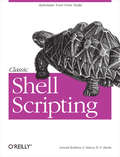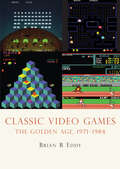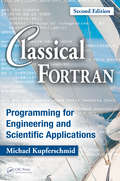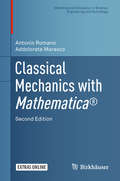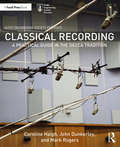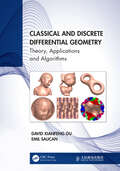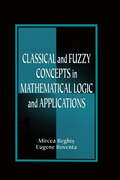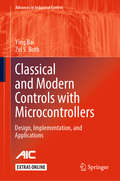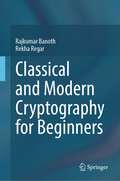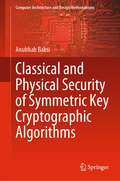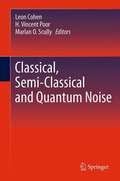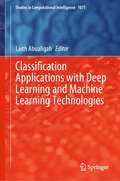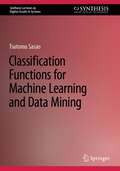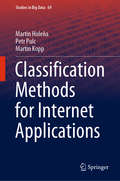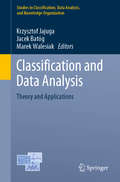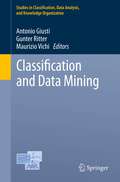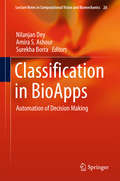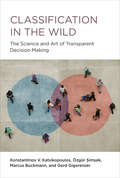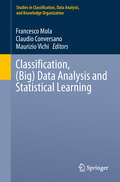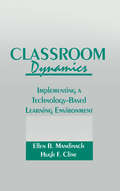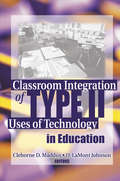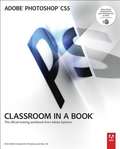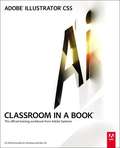- Table View
- List View
Classic Shell Scripting: Hidden Commands that Unlock the Power of Unix
by Arnold Robbins Nelson H. F. BeebeShell scripting skills never go out of style. It's the shell that unlocks the real potential of Unix. Shell scripting is essential for Unix users and system administrators-a way to quickly harness and customize the full power of any Unix system. With shell scripts, you can combine the fundamental Unix text and file processing commands to crunch data and automate repetitive tasks. But beneath this simple promise lies a treacherous ocean of variations in Unix commands and standards. Classic Shell Scripting is written to help you reliably navigate these tricky waters.Writing shell scripts requires more than just a knowledge of the shell language, it also requires familiarity with the individual Unix programs: why each one is there, how to use them by themselves, and in combination with the other programs. The authors are intimately familiar with the tips and tricks that can be used to create excellent scripts, as well as the traps that can make your best effort a bad shell script. With Classic Shell Scripting you'll avoid hours of wasted effort. You'll learn not only write useful shell scripts, but how to do it properly and portably.The ability to program and customize the shell quickly, reliably, and portably to get the best out of any individual system is an important skill for anyone operating and maintaining Unix or Linux systems. Classic Shell Scripting gives you everything you need to master these essential skills.
Classic Video Games
by Brian EddyIn the early 1970s, video arcade games sprung to life with the advent of Pong and other coin-operated games. Within just a few short years, if you had a quarter, you could go to the video arcade and play Space Invaders, Asteroids, or Pac-Man. If you were lucky enough to have an Atari system hooked up to your television, you could play Frogger or Galaga at home. By the early 1980s, arcade and video games were entrenched as a pop culture phenomenon, with players spending hours in arcades racking up as many points as possible. Arcade games were everywhere: restaurants, bowling alleys, department stores, grocery stores--anywhere that could accommodate a three-foot by five-foot machine. But, just as soon as the phenomenon began, it morphed into something else with the advent of hand-held games and more sophisticated home-gaming systems. Brian Eddy, former executive director, producer, and programmer for Midway Games, traces the evolution of arcade video games in Classic Video Games, giving readers an inside look at the stratospheric rise--and collapse--of the industry. Readers will reminisce about their favorite games, such as Centipede, Ms. Pac-Man, Tron, and Star Wars as they relive the glory days of the classic video game rage of the 1970s and 1980s.
Classical Fortran: Programming for Engineering and Scientific Applications, Second Edition
by Michael KupferschmidClassical FORTRAN: Programming for Engineering and Scientific Applications, Second Edition teaches how to write programs in the Classical dialect of FORTRAN, the original and still most widely recognized language for numerical computing. This edition retains the conversational style of the original, along with its simple, carefully chosen subset la
Classical Mechanics with Mathematica® (Modeling and Simulation in Science, Engineering and Technology #0)
by Antonio Romano Addolorata MarascoThis textbook takes a broad yet thorough approach to mechanics, aimed at bridging the gap between classical analytic and modern differential geometric approaches to the subject. Developed by the authors from over 30 years of teaching experience, the presentation is designed to give students an overview of the many different models used through the history of the field—from Newton to Hamilton—while also painting a clear picture of the most modern developments. The text is organized into two parts. The first focuses on developing the mathematical framework of linear algebra and differential geometry necessary for the remainder of the book. Topics covered include tensor algebra, Euclidean and symplectic vector spaces, differential manifolds, and absolute differential calculus. The second part of the book applies these topics to kinematics, rigid body dynamics, Lagrangian and Hamiltonian dynamics, Hamilton–Jacobi theory, completely integrable systems, statistical mechanics of equilibrium, and impulsive dynamics, among others. This new edition has been completely revised and updated and now includes almost 200 exercises, as well as new chapters on celestial mechanics, one-dimensional continuous systems, and variational calculus with applications. Several Mathematica® notebooks are available to download that will further aid students in their understanding of some of the more difficult material. Unique in its scope of coverage and method of approach, Classical Mechanics with Mathematica® will be useful resource for graduate students and advanced undergraduates in applied mathematics and physics who hope to gain a deeper understanding of mechanics.
Classical Recording: A Practical Guide in the Decca Tradition (Audio Engineering Society Presents)
by Mark Rogers Caroline Haigh John DunkerleyClassical Recording: A Practical Guide in the Decca Tradition is the authoritative guide to all aspects of recording acoustic classical music. Offering detailed descriptions, diagrams, and photographs of fundamental recording techniques such as the Decca tree, this book offers a comprehensive overview of the essential skills involved in successfully producing a classical recording. Written by engineers with years of experience working for Decca and Abbey Road Studios and as freelancers, Classical Recording equips the student, the interested amateur, and the practising professional with the required knowledge and confidence to tackle everything from solo piano to opera.
Classical and Discrete Differential Geometry: Theory, Applications and Algorithms
by David Xianfeng Gu Emil SaucanThis book introduces differential geometry and cutting-edge findings from the discipline by incorporating both classical approaches and modern discrete differential geometry across all facets and applications, including graphics and imaging, physics and networks. With curvature as the centerpiece, the authors present the development of differential geometry, from curves to surfaces, thence to higher dimensional manifolds; and from smooth structures to metric spaces, weighted manifolds and complexes, and to images, meshes and networks. The first part of the book is a differential geometric study of curves and surfaces in the Euclidean space, enhanced while the second part deals with higher dimensional manifolds centering on curvature by exploring the various ways of extending it to higher dimensional objects and more general structures and how to return to lower dimensional constructs. The third part focuses on computational algorithms in algebraic topology and conformal geometry, applicable for surface parameterization, shape registration and structured mesh generation. The volume will be a useful reference for students of mathematics and computer science, as well as researchers and engineering professionals who are interested in graphics and imaging, complex networks, differential geometry and curvature.
Classical and Fuzzy Concepts in Mathematical Logic and Applications, Professional Version
by Mircea S. Reghis Eugene RoventaClassical and Fuzzy Concepts in Mathematical Logic and Applications provides a broad, thorough coverage of the fundamentals of two-valued logic, multivalued logic, and fuzzy logic.Exploring the parallels between classical and fuzzy mathematical logic, the book examines the use of logic in computer science, addresses questions in automatic deduction, and describes efficient computer implementation of proof techniques.Specific issues discussed include:Propositional and predicate logicLogic networksLogic programmingProof of correctnessSemanticsSyntaxCompletenesssNon-contradictionTheorems of Herbrand and KalmanThe authors consider that the teaching of logic for computer science is biased by the absence of motivations, comments, relevant and convincing examples, graphic aids, and the use of color to distinguish language and metalanguage. Classical and Fuzzy Concepts in Mathematical Logic and Applications discusses how the presence of these facts trigger a stirring, decisive insight into the understanding process. This view shapes this work, reflecting the authors' subjective balance between the scientific and pedagogic components of the textbook.Usually, problems in logic lack relevance, creating a gap between classroom learning and applications to real-life problems. The book includes a variety of application-oriented problems at the end of almost every section, including programming problems in PROLOG III. With the possibility of carrying out proofs with PROLOG III and other software packages, readers will gain a first-hand experience and thus a deeper understanding of the idea of formal proof.
Classical and Modern Controls with Microcontrollers: Design, Implementation And Applications (Advances in Industrial Control)
by Ying Bai Zvi S. RothThis book focuses on the design, implementation and applications of embedded systems and advanced industrial controls with microcontrollers. It combines classical and modern control theories as well as practical control programming codes to help readers learn control techniques easily and effectively. The book covers both linear and nonlinear control techniques to help readers understand modern control strategies. The author provides a detailed description of the practical considerations and applications in linear and nonlinear control systems. They concentrate on the ARM® Cortex®-M4 MCU system built by Texas Instruments™ called TM4C123GXL, in which two ARM® Cortex®-M4 MCUs, TM4C123GH6PM, are utilized. In order to help the reader develop and build application control software for a specified microcontroller unit. Readers can quickly develop and build their applications by using sample project codes provided in the book to access specified peripherals. The book enables readers to transfer from one interfacing protocol to another, even if they only have basic and fundamental understanding and basic knowledge of one interfacing function. Classical and Modern Controls with Microcontrollers is a powerful source of information for control and systems engineers looking to expand their programming knowledge of C, and of applications of embedded systems with microcontrollers. The book is a textbook for college students majored in CE, EE and ISE to learn and study classical and modern control technologies. The book can also be adopted as a reference book for professional programmers working in modern control fields or related to intelligent controls and embedded computing and applications. Advances in Industrial Control reports and encourages the transfer of technology in control engineering. The rapid development of control technology has an impact on all areas of the control discipline. The series offers an opportunity for researchers to present an extended exposition of new work in all aspects of industrial control.
Classical and Modern Cryptography for Beginners
by Rajkumar Banoth Rekha RegarThis textbook offers the knowledge and the mathematical background or techniques that are required to implement encryption/decryption algorithms or security techniques. It also provides the information on the cryptography and a cryptosystem used by organizations and applications to protect their data and users can explore classical and modern cryptography. The first two chapters are dedicated to the basics of cryptography and emphasize on modern cryptography concepts and algorithms. Cryptography terminologies such as encryption, decryption, cryptology, cryptanalysis and keys and key types included at the beginning of this textbook . The subsequent chapters cover basic phenomenon of symmetric and asymmetric cryptography with examples including the function of symmetric key encryption of websites and asymmetric key use cases. This would include security measures for websites, emails, and other types of encryptions that demand key exchange over a public network.Cryptography algorithms (Caesar cipher, Hill cipher, Playfair cipher, Vigenere cipher, DES, AES, IDEA, TEA, CAST, etc.) which are varies on algorithmic criteria like- scalability, flexibility, architecture, security, limitations in terms of attacks of adversary. They are the core consideration on which all algorithms differs and applicable as per application environment. The modern cryptography starts from invent of RSA (Rivest-Shamir-Adleman) which is an asymmetric key algorithm based on prime numbers. Nowadays it is enabled with email and digital transaction over the Internet. This textbook covers Chinese remainder theorem, Legendre, Jacobi symbol, Rabin cryptosystem, generalized ElGamal public key cryptosystem, key management, digital signatures, message authentication, differential cryptanalysis, linear cryptanalysis, time-memory trade-off attack, network security, cloud security, blockchain, bitcoin, etc. as well as accepted phenomenon under modern cryptograph. Advanced level students will find this textbook essential for course work and independent study. Computer scientists and engineers and researchers working within these related fields will also find this textbook useful.
Classical and Physical Security of Symmetric Key Cryptographic Algorithms (Computer Architecture and Design Methodologies)
by Anubhab BaksiThis book consolidates several key aspects from the state-of-the-art research in symmetric key cryptography, which is among the cornerstones of digital security. It presents the content in an informative yet beginner-friendly, accompanied with toy examples and comprehensible graphics. In particular, it highlights the recent developments in tool-assisted analysis of ciphers. Furthermore, promising device-dependent attacks, such as fault attack and side channel attacks on symmetric key ciphers, are discussed in detail. One salient feature of this book is to present a detailed analysis of various fault countermeasures. The coverage of our book is quite diverse—it ranges from prerequisite information, latest research contribution as well as future research directions. It caters to students and researchers working in the field of cryptography.
Classical and Quantum Information Theory
by Emmanuel DesurvireInformation theory lies at the heart of modern technology, underpinning all communications, networking, and data storage systems. This book sets out, for the first time, a complete overview of both classical and quantum information theory. Throughout, the reader is introduced to key results without becoming lost in mathematical details. Opening chapters present the basic concepts and various applications of Shannon's entropy, moving on to the core features of quantum information and quantum computing. Topics such as coding, compression, error-correction, cryptography and channel capacity are covered from classical and quantum viewpoints. Employing an informal yet scientifically accurate approach, Desurvire provides the reader with the knowledge to understand quantum gates and circuits. Highly illustrated, with numerous practical examples and end-of-chapter exercises, this text is ideal for graduate students and researchers in electrical engineering and computer science, and practitioners in the telecommunications industry. Further resources and instructor-only solutions are available at www. cambridge. org/9780521881715.
Classical, Semi-classical and Quantum Noise
by H. Vincent Poor Leon Cohen Marlan O. ScullyDavid Middleton was a towering figure of 20th Century engineering and science and one of the founders of statistical communication theory. During the second World War, the young David Middleton, working with Van Fleck, devised the notion of the matched filter, which is the most basic method used for detecting signals in noise. Over the intervening six decades, the contributions of Middleton have become classics. This collection of essays by leading scientists, engineers and colleagues of David are in his honor and reflect the wide influence that he has had on many fields. Also included is the introduction by Middleton to his forthcoming book, which gives a wonderful view of the field of communication, its history and his own views on the field that he developed over the past 60 years. Focusing on classical noise modeling and applications, Classical, Semi-Classical and Quantum Noise includes coverage of statistical communication theory, non-stationary noise, molecular footprints, noise suppression, Quantum error correction, and other related topics.
Classification Applications with Deep Learning and Machine Learning Technologies (Studies in Computational Intelligence #1071)
by Laith AbualigahThis book is very beneficial for early researchers/faculty who want to work in deep learning and machine learning for the classification domain. It helps them study, formulate, and design their research goal by aligning the latest technologies studies’ image and data classifications. The early start-up can use it to work with product or prototype design requirement analysis and its design and development.
Classification Functions for Machine Learning and Data Mining (Synthesis Lectures on Digital Circuits & Systems)
by Tsutomu SasaoThis book introduces a novel perspective on machine learning, offering distinct advantages over neural network-based techniques. This approach boasts a reduced hardware requirement, lower power consumption, and enhanced interpretability. The applications of this approach encompass high-speed classifications, including packet classification, network intrusion detection, and exotic particle detection in high-energy physics. Moreover, it finds utility in medical diagnosis scenarios characterized by small training sets and imbalanced data. The resulting rule generated by this method can be implemented either in software or hardware. In the case of hardware implementation, circuit design can employ look-up tables (memory), rather than threshold gates.The methodology described in this book involves extracting a set of rules from a training set, composed of categorical variable vectors and their corresponding classes. Unnecessary variables are eliminated, and the rules are simplified before being transformed into a sum-of-products (SOP) form. The resulting SOP exhibits the ability to generalize and predict outputs for new inputs. The effectiveness of this approach is demonstrated through numerous examples and experimental results using the University of California-Irvine (UCI) dataset.This book is primarily intended for graduate students and researchers in the fields of logic synthesis, machine learning, and data mining. It assumes a foundational understanding of logic synthesis, while familiarity with linear algebra and statistics would be beneficial for readers.
Classification Methods for Internet Applications (Studies in Big Data #69)
by Martin Holeňa Petr Pulc Martin KoppThis book explores internet applications in which a crucial role is played by classification, such as spam filtering, recommender systems, malware detection, intrusion detection and sentiment analysis. It explains how such classification problems can be solved using various statistical and machine learning methods, including K nearest neighbours, Bayesian classifiers, the logit method, discriminant analysis, several kinds of artificial neural networks, support vector machines, classification trees and other kinds of rule-based methods, as well as random forests and other kinds of classifier ensembles. The book covers a wide range of available classification methods and their variants, not only those that have already been used in the considered kinds of applications, but also those that have the potential to be used in them in the future. The book is a valuable resource for post-graduate students and professionals alike.
Classification and Data Analysis: Theory and Applications (Studies in Classification, Data Analysis, and Knowledge Organization)
by Krzysztof Jajuga Jacek Batóg Marek WalesiakThis volume gathers peer-reviewed contributions on data analysis, classification and related areas presented at the 28th Conference of the Section on Classification and Data Analysis of the Polish Statistical Association, SKAD 2019, held in Szczecin, Poland, on September 18–20, 2019. Providing a balance between theoretical and methodological contributions and empirical papers, it covers a broad variety of topics, ranging from multivariate data analysis, classification and regression, symbolic (and other) data analysis, visualization, data mining, and computer methods to composite measures, and numerous applications of data analysis methods in economics, finance and other social sciences. The book is intended for a wide audience, including researchers at universities and research institutions, graduate and doctoral students, practitioners, data scientists and employees in public statistical institutions.
Classification and Data Mining (Studies in Classification, Data Analysis, and Knowledge Organization #0)
by Maurizio Vichi Antonio Giusti Gunter RitterThis volume contains both methodological papers showing new original methods, and papers on applications illustrating how new domain-specific knowledge can be made available from data by clever use of data analysis methods. The volume is subdivided in three parts: Classification and Data Analysis; Data Mining; and Applications. The selection of peer reviewed papers had been presented at a meeting of classification societies held in Florence, Italy, in the area of "Classification and Data Mining".
Classification in BioApps: Automation of Decision Making (Lecture Notes in Computational Vision and Biomechanics #26)
by Nilanjan Dey Amira S. Ashour Surekha BorraThis book on classification in biomedical image applications presents original and valuable research work on advances in this field, which covers the taxonomy of both supervised and unsupervised models, standards, algorithms, applications and challenges. Further, the book highlights recent scientific research on artificial neural networks in biomedical applications, addressing the fundamentals of artificial neural networks, support vector machines and other advanced classifiers, as well as their design and optimization. In addition to exploring recent endeavours in the multidisciplinary domain of sensors, the book introduces readers to basic definitions and features, signal filters and processing, biomedical sensors and automation of biomeasurement systems. The target audience includes researchers and students at engineering and medical schools, researchers and engineers in the biomedical industry, medical doctors and healthcare professionals.
Classification in the Wild: The Science and Art of Transparent Decision Making
by Gerd Gigerenzer Konstantinos V. Katsikopoulos Ozgur Simsek Marcus BuckmannRules for building formal models that use fast-and-frugal heuristics, extending the psychological study of classification to the real world of uncertainty.This book focuses on classification--allocating objects into categories--"in the wild," in real-world situations and far from the certainty of the lab. In the wild, unlike in typical psychological experiments, the future is not knowable and uncertainty cannot be meaningfully reduced to probability. Connecting the science of heuristics with machine learning, the book shows how to create formal models using classification rules that are simple, fast, and transparent and that can be as accurate as mathematically sophisticated algorithms developed for machine learning.
Classification, (Studies In Classification, Data Analysis, And Knowledge Organization Ser.)
by Maurizio Vichi Francesco Mola Claudio ConversanoThis edited book focuses on the latest developments in classification, statistical learning, data analysis and related areas of data science, including statistical analysis of large datasets, big data analytics, time series clustering, integration of data from different sources, as well as social networks. It covers both methodological aspects as well as applications to a wide range of areas such as economics, marketing, education, social sciences, medicine, environmental sciences and the pharmaceutical industry. In addition, it describes the basic features of the software behind the data analysis results, and provides links to the corresponding codes and data sets where necessary. This book is intended for researchers and practitioners who are interested in the latest developments and applications in the field. The peer-reviewed contributions were presented at the 10th Scientific Meeting of the Classification and Data Analysis Group (CLADAG) of the Italian Statistical Society, held in Santa Margherita di Pula (Cagliari), Italy, October 8–10, 2015.
Classroom Dynamics: Implementing a Technology-Based Learning Environment
by Ellen B. Mandinach Hugh F. ClineThis book reports an attempt to introduce change in schools using a computer-based curriculum innovation for teaching higher-order thinking skills to middle and high school students. One of the volume's themes is the extraordinary complexity and difficulty of facilitating such change in schools. A corollary of that theme is the fact that patience must be an integral part of the strategy when promoting or studying change in schools. In reporting the activities during the early years of a technological innovation and research project in which the emphasis thus far has been primarily on establishing the change, this book focuses on describing the move to a technology-based learning environment. As such, it details an ongoing process -- a fascinating process -- and one that is likely to be repeated in the near future in countless schools throughout the nation.
Classroom Integration of Type II Uses of Technology in Education
by Cleborne D MadduxDevelop new strategies for using computers in the classroomEducators have talked about using information technology to improve teaching since the beginning of the modern computer movement but true integration remains an elusive goal-for most. Classroom Integration of Type II Uses of Technology in Education finds teachers who have managed to take advantage of the sophistication, power, and affordability of today&’s technology to develop new and better strategies for learning, despite the absence of an effective institutional infrastructure. This unique book reviews effective Type II teaching applications and software used at all educational levels, including Lego/Logo technologies, idea technologies, graphics software, laptop computers, and handheld computers. Information technology in schools has failed to fulfill its considerable potential because without a widespread instructional support system, computers are generally poorly used and not integrated meaningfully into classroom activities. But some educators have still been able to implement Type II applications of information technology in their educational settings. Classroom Integration of Type II Uses of Technology in Education looks at their innovative methods of using computers to bring about more effective teaching-and learning.Classroom Integration of Type II Uses of Technology in Education examines: computer activities of grade 1-5 students using Lego/Logo technologies using Kid-Pix graphics software for creative activities the Technology Integration Assessment Instrument (TIAI) gender disparity in computer-oriented problem solving a three-tiered, idea-technology classification system pre-service teacher preparation assistive technology definitions, legislation, and implementation issues lesson plans and document techniques for laptop computers an action/instructional model for using handheld wireless computers in the classroom Classroom Integration of Type II Uses of Technology in Education is an invaluable resource for academics working in information technology and education, and for K-12 teachers and administrators at all levels.
Classroom in a Book: The Official Training Workbook
by Adobe SystemsThis official guide to Adobe's popular Photoshop CS5 provides step-by-step instructions for performing common tasks with this ubiquitous image manipulation application. Beginning with an overview of the software and the desktop environment, the volume covers such topics as photo corrections, working with selection tools, layers, enhancing digital photos, masks and channels, typography, vector drawing, advanced compositing, 3D images and the preparation of finished files for printing or the web. The material is well-illustrated with numerous color figures and screen shots and a DVD-Rom containing sample files and video tutorials is included. This is an official publication from Adobe.
Classroom in a Book: The Official Training Workbook
by Adobe SystemsCreative professionals seeking the fastest, easiest, most comprehensive way to learn Adobe Illustrator CS5 choose Adobe Illustrator CS5 Classroom in a Book from the Adobe Creative Team at Adobe Press. The 15 project-based lessons in this book show readers step-by-step the key techniques for working in Illustrator CS5. Readers learn how to create vector artwork for virtually any project and across multiple media: print, websites, interactive projects, and video. In addition to learning the key elements of the Illustrator interface, they'll learn how to integrate their artwork with Adobe Flash movies, Adobe In Design layouts, and Adobe Flash Catalyst software to add interaction to their designs. This completely revised CS5 edition covers new perspective drawing tools, variable-width watercolor strokes, multiple art boards with video-specific presets, the new realistic Bristle brush and Shape Builder tool, and the ability to maintain consistent raster effects across media. "The Classroom in a Book series is by far the best training material on the market. Everything you need to master the software is included: clear explanations of each lesson, step-by-step instructions, and the project files for the students. " -Barbara Binder, Adobe Certified Instructor, Rocky Mountain Training Classroom in a Book , the best-selling series of hands-on software training workbooks, helps you learn the features of Adobe software quickly and easily. Classroom in a Book offers what no other book or training program does-an official training series from Adobe Systems Incorporated, developed with the support of Adobe product experts.
Classroom in the Cloud: Innovative Ideas for Higher Level Learning
by Jared Covili Nicholas ProvenzanoThe sky’s not the limit anymore—get your head in the cloud! Making the most of the digital age in education just got easier. With cloud computing, students can connect with teachers, educators can connect with colleagues, and opportunities for meaningful collaboration can grow exponentially. In this easy-to-use primer, the author of bestseller Going Google teams up with Twitter’s The Nerdy Teacher to demonstrate what cloud-based instruction can mean for teachers and students—and how it can work for your school. The book includes Practical tools for integrating cloud computing into the curriculum Student and teacher testimonies detailing examples of cloud-based instruction in action Chapters on storing, communicating, sharing, and creating Strategies for ensuring safety and security for students and information "This book provides direct quotes from teachers and students about amazing cloud-based applications. You’ll find innovative tools and practices, step-by-step instructions for implementation, and an array of tools for all grade levels and subjects. The classroom may now be in the cloud, but this book will be at my side anytime I need tech tools that are creative, easy-to-use, and fun for teaching and learning." Mark Barnes, Author of Teaching the iStudent and 5 Skills for the Global Learner "It’s more important today than ever before for educators to look beyond the walls of classrooms and connect with other colleagues in their buildings and across the globe. This book will equip all educators with the tools necessary to find the best tools to enhance and improve their teaching practices." Steven Anderson, Author, The Relevant Educator and Content Curation, @web20classroom
